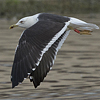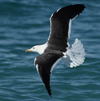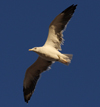| adult fuscus: January
In the adult August section, you can find adult fuscus, which may moult the inner one or two primaries in N Europe on the breeding grounds. Quickly aftewr August, the birds migrate south, and for this long journey the moult is arrested. By doing so, they with a full hand of flight-feathers, and do not spend energy on the moult process.
Adult fuscus arrive at the stop-over sites and winter sites with either:
- 10 old primaries
- P1 replaced
- P1-P2 replaced.
This is the normal moult stage as described by Jonsson and is illsutrated by many example birds. (searching long enough will probably result in birds which also replaced P3, but that's a minority).
As soon as birds arrive in S Europe and Africa, primary moult is started (again) and a complete moult takes place, normally in the ordinary sequence as it is found in many large white-headed gull taxa in N Europe. By January they reach the end of this complete moult. The table below illustrate the moult scores for Israelian birds, photographed by Amir Ben Dov.
Table adult January
Table showing old and new primaries in adult fuscus in January (data from 01-20 January); data for Israel (2008-2011).
P6 new = P6 longest new primary; it exceeds the previous primary in length (so P6 new / fully grown, only from the moment when it is longer than P5).
|
PMS
|
P6 new
|
P7 new
|
P8 new
|
P9 new
|
P10 new
|
total
|
|
0 old
|
.
|
2
|
14
|
5
|
2
|
23
|
|
P10 old
|
.
|
2
|
.
|
.
|
.
|
2
|
|
P9-P10 old
|
1
|
2
|
.
|
.
|
.
|
3
|
|
total
|
1
|
6
|
14
|
5
|
2
|
28
|
INTRASPECIFIC PREDATION AND COLONIAL BREEDING IN LESSER BLACK-BACKED GULLS LARUS FUSCUS
J. W. F. Davis, E. K. Dunn, 1976 IN: Ibis, Volume 118, Issue 1, pages 65–77, January 1976
Summary
The breeding biology of Lesser Black-backed Gulls was studied on Skokholm Island, Pembrokeshire, where the number of breeding pairs has been increasing at about 20% per annum since 1963. Laying was found to be synchronous within small groups.
Clutch size and breeding success showed seasonal declines over the spread of breeding. The loss mainly of eggs, but to a lesser extent of chicks also, caused this overall decline in success. Hide observations indicated that the bulk of these losses arose through predation by nesting adult Lesser Black-backed Gulls on their nearest neighbours.
Not infrequently the protagonist had lost its own clutch shortly before turning predator, and such a chain-sequence should lead to a steady build-up of aggressive failed breeders and so account for the observed seasonal increase in egg loss. Attentiveness to the clutch decreased with season but this was unlikely to have been important in precipitating the predation.
Intermediate plant cover was associated with highest nest density and also with highest chick survival. In addition, nest density was directly correlated with chick survival. Whether plant cover and nest density separately affect chick production remains unresolved. Nevertheless, the increasing nest densities in this colony caused by the growth of the gull population are thought to be responsible for the widespread intraspecific predation, the intensity of which is probably a new feature of the gulls' breeding behaviour. The implications of this ‘internal’ predation for laying synchrony and aggregated nesting are discussed; these two factors of the breeding pattern probably evolved largely to combat ‘external’ predators.
Not only are they no protection against inter-neighbour predation but appear to facilitate it. It remains to be seen whether this kind of predation will significantly affect breeding patterns with further increases in nest density.
Hop or jump: Autumn migration strategies of Lesser Blackbacked Gulls Larus fuscus as revealed by satellite tracking
Kube, J., A.J. Helbig, R. Juvaste, K. Pedersen, C. Rahbek & P. Saurola



|
Fuscus from Norway |
 L. f. fuscus adult J0X0 January 2008, February 2008 & 2009, Ashdod, Israel. Pictures: Amir Ben Dov. L. f. fuscus adult J0X0 January 2008, February 2008 & 2009, Ashdod, Israel. Pictures: Amir Ben Dov.
End of primary moult. |
 L. f. fuscus adult J20E January 02 2010, Ashdod, Israel. Picture: Amir Ben Dov. Bird from Norway. L. f. fuscus adult J20E January 02 2010, Ashdod, Israel. Picture: Amir Ben Dov. Bird from Norway. |
 L. f. fuscus adult J475 January 22 2011, Ashdod, Israel. Picture: Amir Ben Dov.Bird from Norway. P7 fully grown. L. f. fuscus adult J475 January 22 2011, Ashdod, Israel. Picture: Amir Ben Dov.Bird from Norway. P7 fully grown. |
 L. f. fuscus 8CY JLJ0 January 09 2013, Ashdod, Israel. Picture: Amir Ben Dov. P6/P9. L. f. fuscus 8CY JLJ0 January 09 2013, Ashdod, Israel. Picture: Amir Ben Dov. P6/P9. |
| Fuscus from Sweden |
 L. f. fuscus adult SVS 8082672 January 09 2013, Ashdod, Israel. Picture: Amir Ben Dov. Complete moult: P8/-. L. f. fuscus adult SVS 8082672 January 09 2013, Ashdod, Israel. Picture: Amir Ben Dov. Complete moult: P8/-. |
| Fuscus from Finland |
 L. f. fuscus 5cy C00F January 20 2010, Ashdod, Israel. Picture: Amir Ben Dov. Complete moult finished. L. f. fuscus 5cy C00F January 20 2010, Ashdod, Israel. Picture: Amir Ben Dov. Complete moult finished. |
 L. f. fuscus 8cy C13L January 31 2014, Ashdod, Israel. Picture: Amir Ben Dov. Complete moult: P10 growing. L. f. fuscus 8cy C13L January 31 2014, Ashdod, Israel. Picture: Amir Ben Dov. Complete moult: P10 growing. |
 L. f. fuscus 4cy-6cy CC14 January 2008 & February 2009, Ashdod, Israel. Pictures: Amir Ben Dov & Roni Livne. Primary moult finished. L. f. fuscus 4cy-6cy CC14 January 2008 & February 2009, Ashdod, Israel. Pictures: Amir Ben Dov & Roni Livne. Primary moult finished. |
 L. f. fuscus adult CV21 January 2010 & 2013, Ashdod, Israel. Pictures: Amir Ben Dov. Complete moult almost finished. L. f. fuscus adult CV21 January 2010 & 2013, Ashdod, Israel. Pictures: Amir Ben Dov. Complete moult almost finished. |
 L. f. fuscus adult C770 January 02 2010, Ashdod, Israel. Picture: Amir Ben Dov. Complete moult almost finished. L. f. fuscus adult C770 January 02 2010, Ashdod, Israel. Picture: Amir Ben Dov. Complete moult almost finished. |
 L. f. fuscus adult C0PE January 2010 & 2013, Ashdod, Israel. Pictures: Amir Ben Dov. P8 fully grown. Also seen in December. L. f. fuscus adult C0PE January 2010 & 2013, Ashdod, Israel. Pictures: Amir Ben Dov. P8 fully grown. Also seen in December. |
 L. f. fuscus adult C3K2 January 20 2010, Ashdod, Israel. Pictures: Amir Ben Dov. P9 fully grown. L. f. fuscus adult C3K2 January 20 2010, Ashdod, Israel. Pictures: Amir Ben Dov. P9 fully grown. |
 L. f. fuscus adult C3N5 January 20 2010, Ashdod, Israel. Pictures: Amir Ben Dov. P9 fully grown. L. f. fuscus adult C3N5 January 20 2010, Ashdod, Israel. Pictures: Amir Ben Dov. P9 fully grown. |
 L. f. fuscus adult C3X3 January 20 2010, Ashdod, Israel. Pictures: Amir Ben Dov. P8 fully grown. L. f. fuscus adult C3X3 January 20 2010, Ashdod, Israel. Pictures: Amir Ben Dov. P8 fully grown. |
 L. f. fuscus adult C3Y1 January 20 2010, Ashdod, Israel. Pictures: Amir Ben Dov. P8 fully grown. Also from February and December. L. f. fuscus adult C3Y1 January 20 2010, Ashdod, Israel. Pictures: Amir Ben Dov. P8 fully grown. Also from February and December. |
 L. f. fuscus adult C9S0 January 02 2010, Ashdod, Israel. Pictures: Amir Ben Dov. Complete moult almost finished. L. f. fuscus adult C9S0 January 02 2010, Ashdod, Israel. Pictures: Amir Ben Dov. Complete moult almost finished. |
 L. f. fuscus CH 1x January 09 2013, Ashdod, Israel. Pictures: Amir Ben Dov. Code not completely read. L. f. fuscus CH 1x January 09 2013, Ashdod, Israel. Pictures: Amir Ben Dov. Code not completely read. |
 L. f. fuscus CJP3 January 02 2010, Ashdod, Israel. Pictures: Amir Ben Dov. Complete moult almost finished. L. f. fuscus CJP3 January 02 2010, Ashdod, Israel. Pictures: Amir Ben Dov. Complete moult almost finished. |
 L. f. fuscus CNN7 January 02 2010, Ashdod, Israel. Pictures: Amir Ben Dov. Small moult gap. P9-P10 still old. L. f. fuscus CNN7 January 02 2010, Ashdod, Israel. Pictures: Amir Ben Dov. Small moult gap. P9-P10 still old. |
 heuglini / fuscus 5CY U0JD 2010-2013, Ashdod, Israel. Picture: Amir Ben Dov & April 2013 Poland, Picture: Mariusz Dabek. heuglini / fuscus 5CY U0JD 2010-2013, Ashdod, Israel. Picture: Amir Ben Dov & April 2013 Poland, Picture: Mariusz Dabek. |
 L. f. fuscus adult January 09 2008, Ashdod, Israel. Picture: Amir Ben Dov. End of complete moult. L. f. fuscus adult January 09 2008, Ashdod, Israel. Picture: Amir Ben Dov. End of complete moult. |
 L. f. fuscus adult January 09 2008, Ashdod, Israel. Picture: Amir Ben Dov. End of complete moult. L. f. fuscus adult January 09 2008, Ashdod, Israel. Picture: Amir Ben Dov. End of complete moult. |
 L. f. fuscus adult January 06 2010, Ashdod, Israel. Picture: Amir Ben Dov. End of complete moult. L. f. fuscus adult January 06 2010, Ashdod, Israel. Picture: Amir Ben Dov. End of complete moult. |
 L. f. fuscus adult January 06 2010, Ashdod, Israel. Picture: Amir Ben Dov. End of primary moult. L. f. fuscus adult January 06 2010, Ashdod, Israel. Picture: Amir Ben Dov. End of primary moult. |
 L. f. fuscus adult January 06 2010, Ashdod, Israel. Picture: Amir Ben Dov. End of primary moult. L. f. fuscus adult January 06 2010, Ashdod, Israel. Picture: Amir Ben Dov. End of primary moult. |
 L. f. fuscus adult January 06 2010, Ashdod, Israel. Picture: Amir Ben Dov. P9 fully grown. L. f. fuscus adult January 06 2010, Ashdod, Israel. Picture: Amir Ben Dov. P9 fully grown. |
 L. f. fuscus adult January 06 2010, Ashdod, Israel. Picture: Amir Ben Dov. P8 fully grown. Note missing gc. L. f. fuscus adult January 06 2010, Ashdod, Israel. Picture: Amir Ben Dov. P8 fully grown. Note missing gc. |
 L. f. fuscus adult January 11 2013, Ashdod, Israel. Picture: Amir Ben Dov. P7 fully grown. L. f. fuscus adult January 11 2013, Ashdod, Israel. Picture: Amir Ben Dov. P7 fully grown. |
 L. f. fuscus adult January 06 2010, Ashdod, Israel. Picture: Amir Ben Dov. P6 fully grown. L. f. fuscus adult January 06 2010, Ashdod, Israel. Picture: Amir Ben Dov. P6 fully grown. |
 L. f. fuscus adult January 08 2010, Ashdod, Israel. Picture: Amir Ben Dov. End of primary moult. L. f. fuscus adult January 08 2010, Ashdod, Israel. Picture: Amir Ben Dov. End of primary moult. |
 L. f. fuscus adult January 08 2010, Ashdod, Israel. Picture: Amir Ben Dov. End of primary moult. L. f. fuscus adult January 08 2010, Ashdod, Israel. Picture: Amir Ben Dov. End of primary moult. |
 L. f. fuscus adult January 08 2010, Ashdod, Israel. Picture: Amir Ben Dov. End of primary moult. L. f. fuscus adult January 08 2010, Ashdod, Israel. Picture: Amir Ben Dov. End of primary moult. |
 L. f. fuscus adult January 20 2010, Ashdod, Israel. Picture: Amir Ben Dov.P8 fully grown. L. f. fuscus adult January 20 2010, Ashdod, Israel. Picture: Amir Ben Dov.P8 fully grown. |
 L. f. fuscus adult January 09 2013, Ashdod, Israel. Picture: Amir Ben Dov. P9 fully grown. L. f. fuscus adult January 09 2013, Ashdod, Israel. Picture: Amir Ben Dov. P9 fully grown. |
 L. f. fuscus adult January 05 2013, Ashdod, Israel. Picture: Amir Ben Dov. P7 fully grown, L. f. fuscus adult January 05 2013, Ashdod, Israel. Picture: Amir Ben Dov. P7 fully grown, |
 L. f. fuscus adult January 09 2013, Ashdod, Israel. Picture: Amir Ben Dov. P7 fully grown, P10 old. L. f. fuscus adult January 09 2013, Ashdod, Israel. Picture: Amir Ben Dov. P7 fully grown, P10 old. |
 L. f. fuscus adult January 09 2013, Ashdod, Israel. Picture: Amir Ben Dov. P8 fully grown. L. f. fuscus adult January 09 2013, Ashdod, Israel. Picture: Amir Ben Dov. P8 fully grown. |
 L. f. fuscus adult January 09 2013, Ashdod, Israel. Picture: Amir Ben Dov. P8 fully grown. L. f. fuscus adult January 09 2013, Ashdod, Israel. Picture: Amir Ben Dov. P8 fully grown. |
 nominate Lesser Black-backed Gull (L. f. fuscus)
nominate Lesser Black-backed Gull (L. f. fuscus)






















